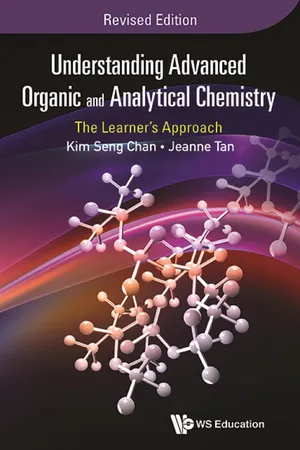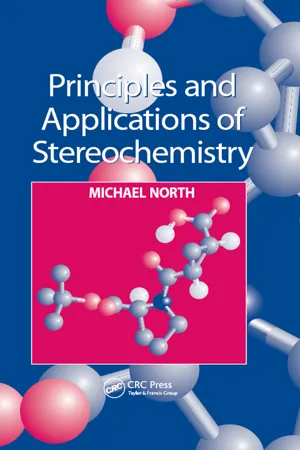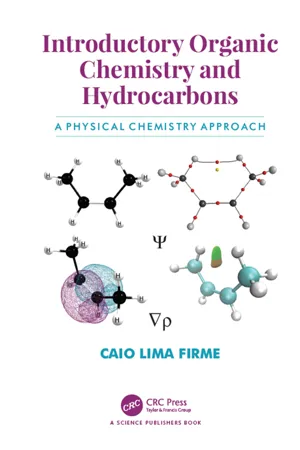Chemistry
Metamerism
Metamerism refers to the phenomenon in organic chemistry where compounds have the same molecular formula but differ in the arrangement of atoms within the molecule. This results in different structural isomers with distinct chemical and physical properties. Metamerism is commonly observed in organic compounds containing heteroatoms, such as oxygen, nitrogen, or sulfur, leading to variations in functional groups and bonding patterns.
Written by Perlego with AI-assistance
Related key terms
Related key terms
1 of 4
Related key terms
1 of 3
5 Key excerpts on "Metamerism"
- eBook - ePub
Carbohydrate Chemistry
Fundamentals and Applications
- Raimo Alén(Author)
- 2018(Publication Date)
- WSPC(Publisher)
3. Isomerism
3.1.General
A general molecular formula (e.g., Cx Hy Oz Nn ) expresses the kind and number of the constituent atoms of a compound, but it insufficiently represents the structure of the compound in question. A molecular formula can thus correspond to several compounds (isomers) that normally have different chemical and physical properties. Isomers can be defined as chemical compounds with identical molecular formulas (i.e., contain the same number of atoms of each element) that differ from one another in the arrangements of their atoms. This phenomenon is called “isomerism” (in Greek, “isos” means “equal” and “meros” “part”), and it is divided into two main types (Fig. 3.1 ): (i)constitutional isomerismor structural isomerism and (ii)stereoisomerismor space isomerism. Upon examining certain isomers (such as aldoses with the same number of carbon atoms), one does not necessarily find differences based on constitutional isomerism, and finding the actual differences requires detailed comparison of the stereoisomeric properties of the structures.Constitutional isomerism can be divided into three subgroups: (i)functional group isomerism(“function isomerism”), (ii)chain isomerism(“skeletal isomerism”), and (iii)position isomerism(“regioisomerism”), which are discussed in the next chapters with the help of illustrative examples. The general name “structural isomerism” is traditionally used for “constitutional isomerism”. However, since the structure of the compounds can be thought to cause all isomerism, the use of the former term is not recommended.Fig. 3.1.The main types of isomerism and their subtypes.The branch of organic chemistry that examines the three-dimensional structures of molecules,stereochemistry, has gained importance when striving to understand the physical and chemical properties of various compounds. In carbohydrate chemistry, it is also essential to know the stereochemical structure of the compounds. Stereoisomerism can be seen to generally represent the form of isomerism where compounds with the same chemical structure (i.e., the order of attachment of the atoms involved and the location of the bonds between them) differ from each other only in the spatial direction of their atoms or atom groups. This isomerism is divided into (i)optical isomerism(“physical isomerism”), (ii)conformational isomerism, and (iii)geometric isomerism(“cis/trans - Roy S. Berns(Author)
- 2019(Publication Date)
- Wiley(Publisher)
Chapter 8 Metamerism and Color InconstancyWe hope our readers recognize that the single most important aspect of color vision, particularly from the standpoint of color technology, is Metamerism. Because of the trichromatic nature of our color vision, spectrally dissimilar stimuli can produce the same visual response. As a consequence, it is possible to produce color matches without using the identical materials. Metamerism has enabled many different color technologies to flourish. Most color reproduction systems including television, photography, movies, and printing rely on three or four primaries to represent our chromatic world. Colorants found to be toxic can be replaced with more benign ones. Colorants can also be replaced in order to reduce cost. Because of Metamerism, it is possible to reformulate a color recipe using different colorants. Designers can coordinate the colored items in a room to match one another despite being made using dissimilar colorants. For these examples, Metamerism is a blessing. It is also a curse because these matches are often conditional, matching for only one observer, and if the metamers are samples, for only one light source. When the change in lighting leads to a large color mismatch, one of the samples changes color dramatically, that is, it exhibits color inconstancy. If either sample can be the standard, the most color constant is a better choice.A. Metamerism TERMINOLOGY
In Chapter 2 , we define Metamerism as the phenomenon in which spectrally different stimuli match to a given observer. We showed an example of a woman standing outdoors and her reproduction on a liquid crystal display. In this chapter, we will focus on physical samples, requiring additional definitions.- Metameric:
- eBook - ePub
Understanding Advanced Organic and Analytical Chemistry
The Learner's ApproachRevised Edition
- Kim Seng Chan, Jeanne Tan;;;(Authors)
- 2016(Publication Date)
- WS EDUCATION(Publisher)
CHAPTER 2
Isomerism in Organic Compounds
2.1 Introduction
If a molecule has the molecular formula C4 H8 , does it imply that all the C4 H8 molecules are identical? The alkene, but-1-ene, whose molecule is shown below, has the molecular formula C4 H8 .Yet, C4 H8 also represents the formula for cyclobutane, which belongs to the cycloalkane family:Compounds that have the same molecular formula but different structures are known as isomers. This phenomenon is known as isomerism. The two main types of isomerism are constitutional/ structural isomerism and stereoisomerism. These are further divided into subclasses of which some are discussed in this chapter. Isomers generally have different physical and chemical properties, but they can also have similar chemical properties if they contain the same functional groups. Each specific functional group possesses a characteristic set of chemical reactions.2.2 Constitutional/Structural Isomerism
Constitutional/structural isomers are compounds with the same molecular formula but different structures or structural formulae. Both but-1-ene and cyclobutane constitute a pair of constitutional/structural isomers. The difference in structures can be attributed to either a difference in the arrangement of atoms or due to the presence of different functional groups.Based on the above definitions, constitutional/structural isomerism can be classified into three main types:• chain isomerism;• positional isomerism; and• functional group isomerism.2.2.1 Chain Isomerism
Compounds that exhibit chain isomerism with each other have the same functional group but differ in the way the carbon atoms are connected in the mainskeletal carbon chain of their molecules. In other words, these molecules differ in the degree of branching, hence the term chain isomers - eBook - ePub
- Michael North(Author)
- 2017(Publication Date)
- Routledge(Publisher)
1.5 respectively. In general, these three isomers will undergo the same types of chemical reaction (benzylic oxidation for example), but will do so at different rates, again illustrating their different chemical properties.There is, however, another type of isomerism, one in which all of the atoms in the two isomers do have the same connectivity. A familiar example is found in 1,2-disubstituted alkenes such as compounds 1.6 and 1.7 . In both of these isomeric compounds, the order in which the carbon atoms are joined together is C𝟙–C𝟚=C𝟛–C𝟜 and the only difference between them is that in isomer 1.6 the two methyl groups are on the same side of the double bond, whilst in isomer 1.7 the two methyl groups are on opposite sides of the double bond. Any pair of isomers which have the same connectivity of their atoms but which differ in the relative orientation of those atoms are called stereoisomers.Stereoisomers are the topic of this book and the following chapters will investigate the different structural features which are responsible for stereoisomerism, and discuss the chemical, biological and physical consequences of the formation of stereoisomers. Both organic and inorganic compounds can exhibit stereoisomerism, and examples of each will be found throughout this book. Essentially, stereochemistry is concerned with the shapes of molecules, and the consequences of a molecule adopting a particular shape.Later in this chapter, the way in which the shape of a molecule may be predicted using Valence Shell Electron Pair Repulsion Theory (VSEPR) will be introduced, and the nature of the bonding found in the most common chemical structures will be discussed. At the end of this chapter, the various classifications of stereoisomers will be introduced and these will be discussed in more detail throughout the remainder of this book. However, many of the structures seen later in this chapter are three dimensional, and before they are discussed it is necessary to understand the conventions used when representing three dimensional structures on a two dimensional piece of paper. - eBook - ePub
Introductory Organic Chemistry and Hydrocarbons
A Physical Chemistry Approach
- Caio Lima Firme(Author)
- 2019(Publication Date)
- CRC Press(Publisher)
Chapter ThirteenIsomerism
ISOMERISM AND TYPES OF ISOMERISM
Isomerism gives rise to isomers that are molecules with the same chemical formula but different structural parameters or different spacial structures (different type of branching or different type of functional group or different position of the same functional group or different arrangement of substituents or different absolute configuration of the asymmetric atom).As for structural isomerism, there are three types: chain isomerism, position isomerism (or regioisomerism), and functional isomerism.The chain isomerism is related to the different position of the branching in its main chain. For example, butane and 2-methyl-propane are isomers (C4 H10 ); pentane, 2-methyl-butane and 2,2-dimethyl-propane are isomers (C5 H12 ); but-1-ene and 2-methyl propene are isomers (C4 H8 ) as well (see Fig. 13.1(A) ).Figure 13.1 Bond line formula of (A) chain isomers, (B) regioisomers, and (C) functional isomers.The position isomerism (or regioisomerism) is related to a different position of the substituent group or functional group in the molecule. For example, but-1-ene and but-2-ene are isomers (C4 H8 ), pentan-2-one and pentan-3-one are isomers (C5 H10 O), 2-chloro-propane and 1-chloro-propane are isomers (C3 H7 Cl), orto-dichlorobenzene and para-dichlorobenzene are isomers (C6 H4 Cl2 ) as well (see Fig. 13.1(B) ).Functional isomerism is related to different functional groups with the same molecular formula. For example, propanone and propanal are isomers (C3 H6 O), hexan-1-ene and cyclohexane (C6 H12 ) are isomers as well (see Fig. 13.1(C) ).Stereoisomerism is related to specific arrangements of substituents where two isomers are differentiated by their spacial disposition. Stereo means spacial.GEOMETRIC STEREOISOMERISM
Geometric stereoisomerm occurs in alkenes or derivatives and in substituted cycloalkanes. They generate two isomers called cis and trans or E and Z.
Index pages curate the most relevant extracts from our library of academic textbooks. They’ve been created using an in-house natural language model (NLM), each adding context and meaning to key research topics.
Explore more topic indexes
Explore more topic indexes
1 of 6
Explore more topic indexes
1 of 4




